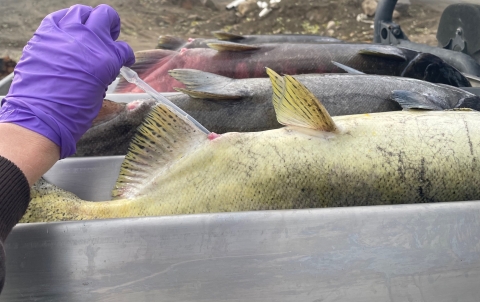Projects and Research
Preventing Disease on Pacific Region Federal Hatcheries and Tribal Partner Hatcheries
Some kinds of salmon, especially spring Chinook, often return from the ocean carrying bacteria that cause a disease in young fish. The bacteria are Renibacterium salmoninarum and the disease that they cause is "Bacterial Kidney Disease," or BKD.
By testing the adult fish, we can collect eggs only from those fish that have low levels of the bacteria and are thus much less likely to pass the bacteria on to their offspring through infected eggs. This spawning method has greatly decreased the impact of BKD on cultured salmon.
Salmon sometimes return from the ocean carrying viruses. The Fish Health Program tests returning broodfish for viruses to prevent the introduction of serious diseases into the young fish raised in hatchery raceways.
The Fish Health Program also monitors the health of all hatchery-raised fish to make sure that disease problems are not developing.
Testing for Fish Disease Problems
Despite our very best efforts at prevention, fish do sometimes develop diseases. These are diseases that are naturally present in hatchery water supplies (rivers and streams) or brought back from the ocean by adult fish. Diseases are treated by changes in their environment (for example, temperature, water flow, feeding) or sometimes through the use of drugs.
Disease diagnosis and treatment in our Fish Health Program is overseen by three veterinarians and other highly trained fish health professionals. Drugs are only used as a last resort and their use is highly controlled by the U.S. Fish and Wildlife Service (Service), FDA (FDA Aquaculture Drug Basics), EPA, USDA, and state authorities.
Protecting the Health of Wild Fish
Every group of fish that we raise is rigorously tested for fish diseases before they leave the hatchery. This ensures that the fish from the hatchery will not cause disease problems for fish already in the wild, and it guarantees that the fish from the hatchery have the best possible chance to survive their trip to the ocean so that they can later return as adults.
Disease inspections and health requirements for the culture and movement of salmon in the Pacific Northwest are governed by the demanding requirements of the states of Washington, Idaho, and Oregon, by tribes, by the Integrated Hatchery Operations Plan (IHOT), by Hatchery Genetics Management Plans (HGMPs), by Service policy, and by federal law.
These include:
• Code of Federal Regulations Title 50
• USDA-APHIS Rules
• World Organization for Animal Health
• Pacific Northwest Fish Health Protection Committee
• Integrated Hatchery Management Operations Team Guidelines
• Washington Co-Managers' Policy
• Oregon State Fish Health Policy
The Fish Health Program also tests thousands of wild fish from throughout Oregon, Washington, and Idaho so that we can better understand the impacts of diseases on wild fish populations.


